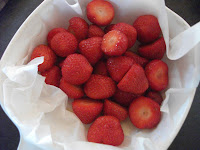I need to start making my own pasta soon (the ex used to take care of that chore, and did it well) - in the meantime, I had some leftover dumpling wrappers which work well enough in a pinch. The title of the recipe refers to chard; in fact, I used a combination of swiss chard and beet greens. Spinach would work just as well.
The butter sauce is very rich (obviously, it's nothing but butter!) so this is really meant to be eaten as an appetizer in small amounts - 3-5 ravioli per person at most. This recipe makes 15-20 ravioli. The sauce makes more than enough for this amount and can probably be cut in half; but better to have it and not need it ...
Ingredients:
1 cup finely chopped greens (swiss chard/beet greens/spinach)
1/2 container ricotta (about 1 cup)
1/8 tsp freshly grated nutmeg
S&P
Dumpling wrappers
1/2 cup unsalted butter
6 large Sage leaves, plus additional chopped sage for garnish
1 lemon
Parmesan cheese
Combine greens with ricotta. Grate in the nutmeg, then add S&P to taste. Ricotta is quite bland, so you'll need some salt, but add a bit at a time so as not to over-salt. Drop a spoonful of filling onto one dumpling wrapper. Keep a bowl of water nearby to wet the edge of each dumpling. Then place the second wrapper over top and press so edges adhere. Be careful to ensure edges are stuck together otherwise the filling will leak out when boiled.

Bring a pot of salted water to a boil, then reduce to a steady simmer (this will help to avoid them splitting apart). The ravioli should take 8-12 minutes. Don't overload the pot too much. Prepare sauce in the meantime.
 In a shallow pan, heat the butter on medium-high until it begins to foam. Allow the foam to subside and do not allow butter to burn. When beginning to brown, remove from heat. Add whole sage leaves, which will sizzle in the heat. After a minute or so, the butter will cool a bit - at this point, squeeze in the juice of 1 lemon.
In a shallow pan, heat the butter on medium-high until it begins to foam. Allow the foam to subside and do not allow butter to burn. When beginning to brown, remove from heat. Add whole sage leaves, which will sizzle in the heat. After a minute or so, the butter will cool a bit - at this point, squeeze in the juice of 1 lemon.When ravioli is ready, gently scoop into the sauce and lightly toss to coat. Serve with parmesan cheese, and chopped sage leaves.






















































